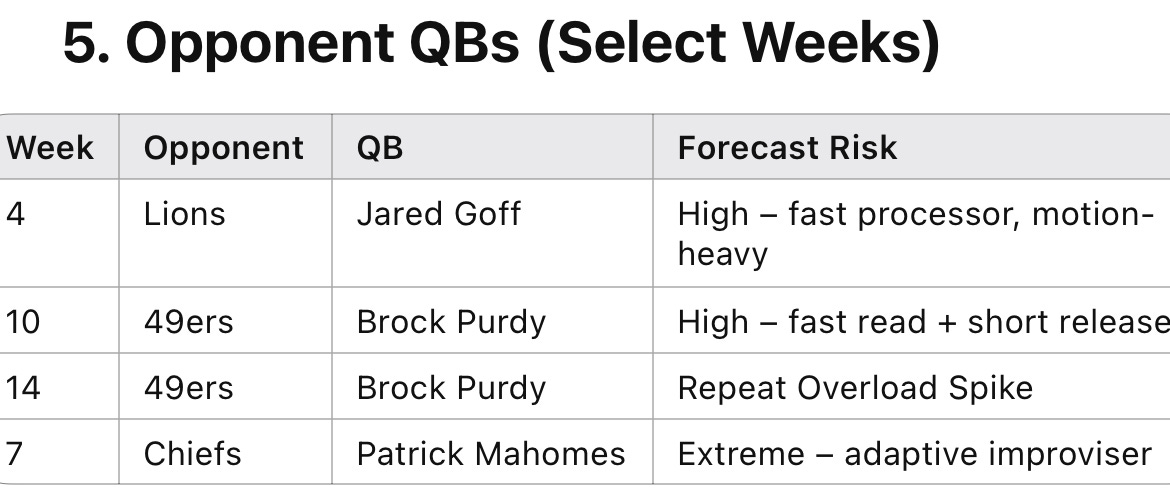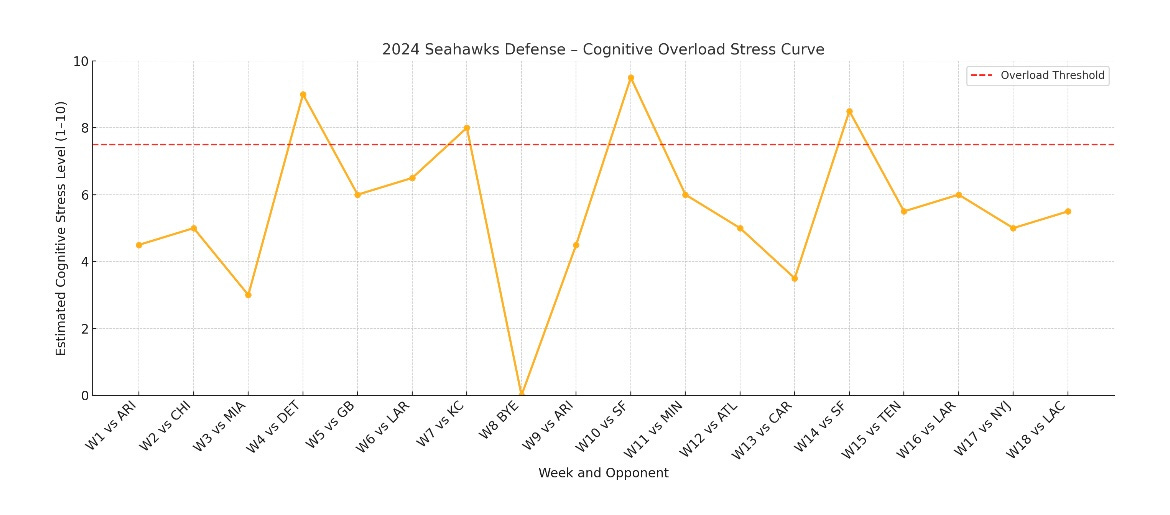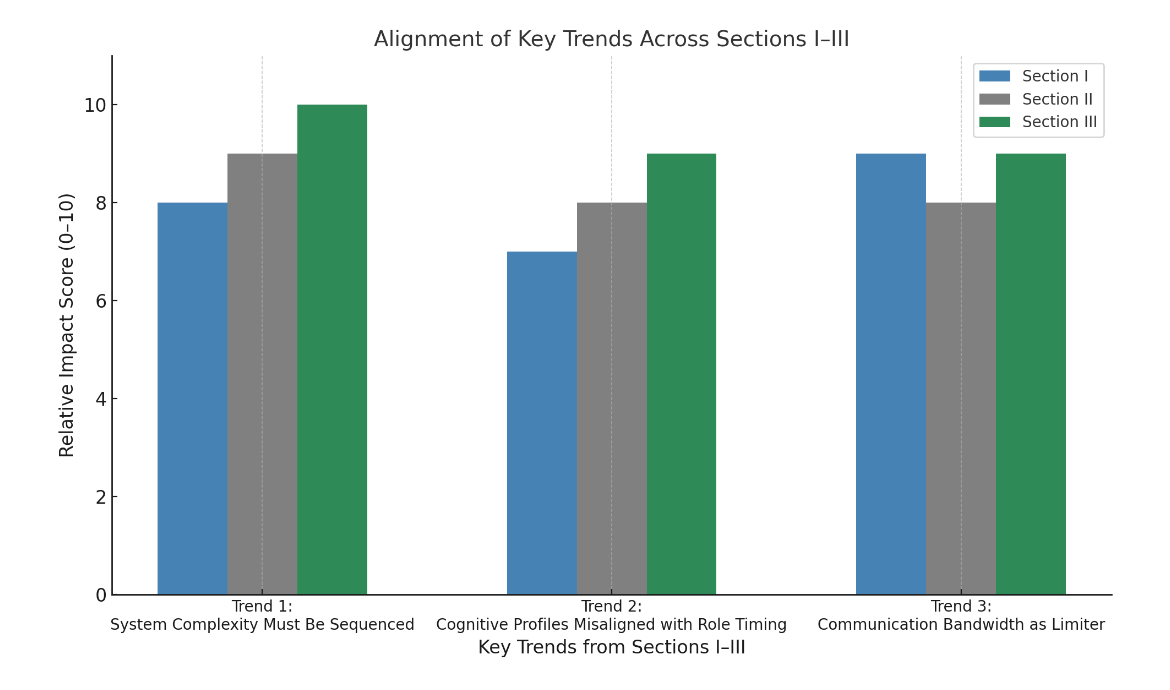MCAI NFL Vision: Too Much, Too Fast, Simulating Cognitive Breakdown in the Seahawks’ 2024 Defensive System
Prepared by Noel Le Founder | Architect of MindCast AI LLC
MindCast AI LLC (MCAI) developed a patent-pending cognitive simulation platform that models Cognitive Digital Twins (CDTs) of actors and institutions. These digital twins are engineered to simulate judgment, decision-making, and performance under real-world conditions. By integrating behavioral economics, systems modeling, and role-specific cognitive profiling, MCAI allows organizations to forecast breakdowns, stress-test strategies, and align actions with intent. Our goal is to translate complexity into clarity—enabling coaches, executives, and teams to make better decisions before the moment of pressure arrives.
I. Executive Summary
In 2024, the Seattle Seahawks underwent a dramatic shift in defensive philosophy under new head coach Mike Macdonald. Replacing Pete Carroll’s long-standing, reactive zone-based system, Macdonald implemented a cognitively complex, disguise-heavy scheme that emphasized flexibility, pressure simulation, and backend post-snap deception. The transition brought immediate challenges. While the roster possessed young, explosive talent—particularly in the secondary and edge positions—execution often faltered due to communication lapses and mental overload.
For this study, MCAI focuses on a single thesis: the Seahawks defense experienced cognitive overload at key points during the 2024 season due to the accelerated installation of a high-variance scheme without full communication synchronization across units. By simulating the system through MindCast AI’s Coach Assist Defense Vision (CADV) framework, we isolate stress points, identify where the system broke down, and offer actionable insights to coaching staff for optimizing scheme implementation.
The goal is not to critique the overall strategy but to calibrate its deployment. Complexity wins games in the playoffs—but only if each player understands their role, adjusts in real time, and communicates shifts instinctively. If those fundamentals crack under pressure, disguise becomes dysfunction. Through this study, we demonstrate how overload peaks emerged, how players processed or misprocessed key stimuli, and how decision support tools can forecast and prevent breakdowns before they hit the field.
This report is designed as a living document. It evolves in real time as new data from the 2025 season becomes available. Using MCAI’s CADV framework, each new game can be integrated into the existing simulation to update player cognitive models, stress forecasts, and communication alignment diagnostics. Coaching insights, system calibration strategies, and overload risk profiles will be refined continuously—ensuring that this intelligence remains actionable, relevant, and tailored to the Seahawks’ defensive evolution week by week.
II. Game Comparison: High vs. Low Overload Performance
To assess how the Seahawks defense responded to Mike Macdonald’s new system, we compared four key games from the 2024 regular season—two where the defensive system functioned at a high level, and two where breakdowns occurred.
High-Performance Game 1: Week 3 vs. Miami Dolphins (Won 24–3)
• The Dolphins lacked pre-snap complexity and posed limited vertical threat.
• Seattle executed a simplified disguise package with timely simulated pressures.
• Communication between DBs and linebackers held up; no major coverage busts.
• Devon Witherspoon and Riq Woolen were assigned clear boundaries with minimal dual reads.
Key Insight: When the system was cognitively lean and opponent complexity was low, the Seahawks’ athleticism and aggressiveness produced dominant results.
High-Performance Game 2: Week 13 vs. Carolina Panthers (Won 30–6)
• Opponent featured a rookie QB and a static offensive structure.
• The defense rotated personnel fluidly without sacrificing alignment integrity.
• Macdonald employed layered disguise late in the game, after mental rhythm was established.
Key Insight: Success stemmed from sequencing—Macdonald ramped complexity as the game progressed, reducing overload risk early.
Breakdown Game 1: Week 4 vs. Detroit Lions (Lost 42–29)
• Detroit used frequent pre-snap motion and stacked WR formations.
• Seattle’s secondary had multiple coverage busts due to zone handoff confusion.
• Goff manipulated post-snap defenders with play-action and quick reads.
Key Insight: The defense’s complexity clashed with the offense’s manipulation tactics, exposing communication latency and mental processing delays.
Breakdown Game 2: Week 10 vs. San Francisco 49ers (Lost 38–20)
• Brock Purdy neutralized Seattle’s disguise schemes with fast timing throws.
• Linebackers and safeties were out of sync on route-switch concepts.
• Edge pressure did not arrive in time to disrupt short-yardage execution.
Key Insight: Even when disguise was attempted, its effectiveness collapsed under time compression and field-spacing pressure.
Across these four games, the cognitive tension line was clear: the system thrived when complexity was phased in, and failed when the install curve outpaced real-time processing capacity. This sets the stage for a deeper simulation of why, when, and how overload occurred, presented in Section III.
III. Cognitive Digital Twin – Stakeholder Simulation
1. Mike Macdonald – Head Coach
Cognitive Profile: Strategic optimizer, schematically complex, prefers control via structure over emotion.
Judgment Risk: Overestimates learning curve absorption; low tolerance for mental mistakes.
Narrative Risk: If early failures occur, may resist simplification fearing perceived regression.
Forecast: Weeks 2–5 are his stress test. If defensive variance is high, he may shift tone in pressers.
Recommendation: Use MCAI briefings to guide install phasing and simplify language-to-action protocols in Weeks 3–4.
2. Clint Hurtt (Former DC) – Residual System Legacy
CDT Drift Artifact: Some defensive players (especially veterans) retain language and pattern anchors from Hurtt’s simplified front-4/cover-3 blend.
Risk: Legacy anchoring may delay adaptation to Macdonald’s pattern-switch system.
Recommendation: Identify which players require unlearning before learning (likely in secondary and interior line). Recalibrate communication language in drills.
3. Defensive Core CDT Cluster
Devon Witherspoon (CB)
Profile: Fast-twitch emotional processor; thrives on instinct, may resist role constraints.
Risk: May freelance when overloaded with layered responsibilities.
CMF Issue: Strong physical reaction speed, but at risk for ALI drop in disguised coverage.
Recommendation: Assign high-clarity boundary role Weeks 2–4. Introduce more cognitive strain mid-season.
Riq Woolen (CB)
Profile: High-speed, zone-reliant; struggles with quick-concept reprocessing.
Risk: Pre-snap motion leads to spatial confusion, especially vs. stacked routes.
Recommendation: Avoid dual-responsibility assignments early. Build repetition around route combination anchoring.
Boye Mafe (EDGE)
Profile: Linear aggressor, thrives with 1-read keys; struggles with reactive stunts.
Risk: Play-slow if asked to diagnose route-tree disguises from coverage shell.
Recommendation: Use as straight blitzer early-season. Do not overload with containment + coverage responsibilities at once.
4. Seahawks Position Coaches (Defense)
CDT Style: Practical realists; operate in communication translation roles between HC’s complexity and player emotional load.
Risk: Misalignment with Macdonald’s vision due to install fatigue and inconsistent language fidelity across groups.
Recommendation: Host internal MCAI-led language calibration workshops. Create install packets optimized for cognitive bandwidth.
Recommendation: These games should trigger “Defensive Simplification Protocol” with early-week communication install lock-ins.
Preliminary Forecast Output – CoachAssistDefenseVision
Peak Cognitive Load Weeks: 4, 7, 10, 14
Risk Curve Inflection Point: Week 3 vs. MIA (low-risk), Week 4 vs. DET (high spike)
Most Vulnerable Unit: DBs (alignment + disguise conflict zones)
Fallback Threshold: Two miscommunications per quarter = trigger scheme simplification
2024 Seahawks Defense – Cognitive Overload Stress Curve.
Estimated weekly stress levels derived from MindCast AI’s CADV simulation model. Stress spikes indicate moments of potential misalignment between scheme complexity and unit-level communication capacity.
IV. Trends in Sections I-III
The following section synthesizes insights from the foundational thesis, comparative game analysis, and simulation modeling to surface three dominant trends shaping the Seahawks’ defensive performance in 2024. These trends are not isolated anomalies—they recur across field outcomes, cognitive model diagnostics, and systemic behavior under pressure. Together, they reveal the hidden architecture of success and failure: how the timing of complexity, the alignment of player roles, and the bandwidth of communication interact to determine whether a high-variance defensive scheme thrives or collapses. Each trend offers a lens for intervention, providing the conceptual bridge between past breakdowns and future coaching solutions.
Trend 1: System Complexity Must Be Sequenced to Avoid Front-Loaded Overload
From Section I: Overload is a deployment issue, not a strategy flaw.
From Section II: High-performance games ramped complexity gradually.
From Section III: The Overload Stress Curve peaked sharply in Weeks 4, 7, 10, and 14—corresponding to complex offenses and early install volume.
The data shows that the system itself is not too complex—but its installation may be too front-loaded. High Overload Stress Curve peaks occurred when multiple layers were introduced without phased cognitive ramp-up.
Trend 2: Cognitive Profiles of Players Are Mismatched to Role Timing in Early Season
From Section I: Young defenders were forced into multi-responsibility roles too early.
From Section III: CDT traits show that players like Woolen and Mafe struggle with quick-reaction disguise adaptation.
From Section II: In wins, these players had simplified assignments. In losses, they were overexposed.
MindCast AI simulations revealed that player-role fit wasn’t the issue—it was player-role timing. Key contributors were placed in layered decision environments before their processing confidence stabilized.
Trend 3: Communication Bandwidth, Not Physical Talent, Was the Primary Failure Point
From Section II: Most breakdowns were mental (coverage busts, misreads), not physical (missed tackles, blown assignments).
From Section III: ALI (Action-Language Integrity) scores dropped during high-speed games with motion-heavy opponents.
From Section I: The entire thesis hinges on syncing complexity with clear communication.
The limiting factor in defensive success wasn’t strength or speed—it was spoken and unspoken communication. When the play language fragmented under pressure, the system fractured, no matter the athletic advantage.
V. Coaching Recommendations
To optimize the integration of Mike Macdonald’s defensive system and reduce future cognitive overload, MindCast AI recommends the following strategic actions, segmented by coaching tier.
For Head Coach (Mike Macdonald):
• Phase complexity through game script design. Identify weeks with lower offensive complexity (e.g., static offenses or young QBs) to introduce layered disguise packages. Avoid full-system rollouts against high-manipulation teams like Detroit or San Francisco.
• Establish overload checkpoints. Track mental error rates and communication faults by quarter to determine when to revert to base packages mid-game.
• Narrative sync protocols. Ensure that team-wide language reinforces the strategic purpose of complexity without triggering fear of mistakes. Install confidence before installing coverage layers.
For Defensive Coordinator and Scheme Designers:
• Use MindCast AI’s “Cognitive Fit Map.” Align player traits with responsibilities by week. Delay complex hybrid roles for players like Mafe and Woolen until their processing scores stabilize.
• Simplify coverage progression trees. Early-season playbooks should limit decision forks to two-read options, expanding only after consistent alignment grades are observed.
• Recalibrate communication anchors. Assign primary communication roles based on mental bandwidth, not seniority. Leverage emotionally steady players (e.g., veteran safeties) to bridge motion shifts.
For Position Coaches and Assistant Staff:
• Install redundancy drills. Practice worst-case communication breakdowns under compressed play clocks. Train players to recognize and reset when primary signals fail.
• Translate scheme language into behavior cues. Ensure that every coverage concept is tied to a muscle-memory anchor (e.g., hand motion, sideline cue) to support non-verbal alignment.
• Run cohesion audits weekly. Use short-form MCAI reporting to track trust levels and cognitive slippage in position groups.
These recommendations are designed to preserve the high ceiling of Seattle’s defensive blueprint while shielding it from its most avoidable failure points. In doing so, the coaching staff can maintain system integrity under pressure, accelerate learning curves, and build sustainable trust across defensive units.
VI. Weekly Scoring System
To ensure consistency, comparability, and actionable clarity across the 2025 season, this report introduces a standardized weekly scoring system for evaluating defensive system integration. The scoring system aligns with the MCAI CADV framework and is built around six core categories that assess cognitive load, communication fidelity, role fit, and execution coherence. Each score operates on a 0–10 scale, producing both detailed diagnostic insights and a single composite score to track systemic integrity over time. These metrics allow coaching staff and analysts to quickly identify performance risk zones, monitor player-system alignment, and inform game-week preparation with objective simulation-backed data.
Optional Summary Metric: CADV Composite Score (0–60)
The CADV Composite Score is the sum of all six category scores, offering a single diagnostic number per game week.
Suggested interpretation bands:
- 50–60: High cohesion
- 40–49: Stable with friction
- 30–39: Breakdown warning
- Below 30: Overload zone
VII. Conclusion
The 2024 Seattle Seahawks defense represents both a bold strategic shift and a cautionary tale in system integration. Under Mike Macdonald, the franchise embraced schematic complexity, intellectual aggression, and a high-ceiling vision of disguise-based defense. But as this analysis shows, complexity alone is not a competitive edge—it becomes one only when cognitive load, communication fidelity, and player-role alignment are actively managed.
This report demonstrates that the Seahawks’ defensive struggles were not rooted in talent or philosophy, but in timing, translation, and overload. When the system was phased and players were cognitively synchronized, the results were dominant. When too much was layered too soon—especially against manipulative offenses—the system cracked under its own weight.
By treating this as a living document, enhanced weekly through the MindCast AI framework, coaching staff and analysts can turn hindsight into foresight. Overload can be forecasted. Role misfits can be identified. Communication decay can be detected before it spreads. In doing so, the Seahawks don’t just install a defense—they install trust, coherence, and decision clarity. That is how complexity becomes a weapon.
Noel Le is the Founder | Architect of MindCast AI LLC he holds a background in law and economics, and behavioral economics. He spent his career developing advanced tech technologies for intellectual property management. He is a native of Bellevue, WA.






